The People vs. Galileo?
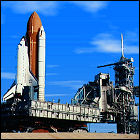 A lawsuit, filed by environmental activists worried about the release of plutonium from the Galileo Jupiter probe’s radioisotope thermoelectric generators in the event of a Challenger-like disaster during launch, is dismissed by a federal judge; the President of the United States has also given permission for the launch to proceed (a requirement anytime a nuclear-fueled spacecraft is in the works). The suit, filed earlier in the year, sought an injunction to prevent Galileo from being launched. Times have changed since the last RTG-powered flight (the Voyager missions of the 1970s), and activists are concerned about a Chernobyl-style radioactive disaster, although the plutonium 238 at the heart of Galileo’s power supply (and that of other interplanetary probes that have used it) is non-weapons-grade and non-fissible. Galileo is slated to be launched in a week aboard the space shuttle Atlantis.
A lawsuit, filed by environmental activists worried about the release of plutonium from the Galileo Jupiter probe’s radioisotope thermoelectric generators in the event of a Challenger-like disaster during launch, is dismissed by a federal judge; the President of the United States has also given permission for the launch to proceed (a requirement anytime a nuclear-fueled spacecraft is in the works). The suit, filed earlier in the year, sought an injunction to prevent Galileo from being launched. Times have changed since the last RTG-powered flight (the Voyager missions of the 1970s), and activists are concerned about a Chernobyl-style radioactive disaster, although the plutonium 238 at the heart of Galileo’s power supply (and that of other interplanetary probes that have used it) is non-weapons-grade and non-fissible. Galileo is slated to be launched in a week aboard the space shuttle Atlantis.
The Chernobyl disaster
 A major accident at the #4 reactor of the Soviet Union’s Chernobyl nuclear power facility, near the border of Ukraine and Belarus, causes a significant release of radioactive material into the air. Much of the material has immediate consequences for the nearby city of Pripyat, but the effects are felt both elsewhere in the Soviet Union and in Europe. Worse still, the Soviet government tries to cover up the incident, until the mounting evidence of a major incident forces them to admit, two days after the fact, that a core meltdown occurred and that the resulting release of radioactive material has international reach and consequences. Some emergency workers die of massive radiation exposure, and an increase is seen in other illnesses, including cancer, in exposed human populations nearby. Over 100,000 people are evacuated from nearby areas. Premature deaths and genetic mutations are observed in nearby wildlife for years after the incident. The costs of mitigation and containment of the toxic reactor site will become a major factor in the collapse of the Soviet Union a few years later. The exclusion zone established around the facility may be a safe place for humans to live again for hundreds, perhaps thousands, of years.
A major accident at the #4 reactor of the Soviet Union’s Chernobyl nuclear power facility, near the border of Ukraine and Belarus, causes a significant release of radioactive material into the air. Much of the material has immediate consequences for the nearby city of Pripyat, but the effects are felt both elsewhere in the Soviet Union and in Europe. Worse still, the Soviet government tries to cover up the incident, until the mounting evidence of a major incident forces them to admit, two days after the fact, that a core meltdown occurred and that the resulting release of radioactive material has international reach and consequences. Some emergency workers die of massive radiation exposure, and an increase is seen in other illnesses, including cancer, in exposed human populations nearby. Over 100,000 people are evacuated from nearby areas. Premature deaths and genetic mutations are observed in nearby wildlife for years after the incident. The costs of mitigation and containment of the toxic reactor site will become a major factor in the collapse of the Soviet Union a few years later. The exclusion zone established around the facility may be a safe place for humans to live again for hundreds, perhaps thousands, of years.
Test No. 6
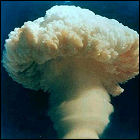 The People’s Republic of China conducts a nuclear weapons test under the nondescript code name Test No. 6, which is in fact China’s first thermonuclear (hydrogen) bomb test. Dropped by an aircraft, Test No. 6 has a yield of 3.3 megatons. For context, China had conducted its first nuclear test barely three years earlier.
The People’s Republic of China conducts a nuclear weapons test under the nondescript code name Test No. 6, which is in fact China’s first thermonuclear (hydrogen) bomb test. Dropped by an aircraft, Test No. 6 has a yield of 3.3 megatons. For context, China had conducted its first nuclear test barely three years earlier.
Project 596
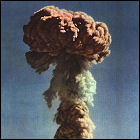 The People’s Republic of China detonates its first nuclear weapon, the 22-kiloton Project 596. Though the Chinese nuclear program did receive an early boost from Soviet researchers, much of the research and production of Chinese nuclear weapons has taken place without outside help since the initiation of the Chinese nuclear weapons development program in 1959. Within three years of this test, China will have developed hydrogen bomb technology.
The People’s Republic of China detonates its first nuclear weapon, the 22-kiloton Project 596. Though the Chinese nuclear program did receive an early boost from Soviet researchers, much of the research and production of Chinese nuclear weapons has taken place without outside help since the initiation of the Chinese nuclear weapons development program in 1959. Within three years of this test, China will have developed hydrogen bomb technology.
Project Orion: lunar and Mars missions studied
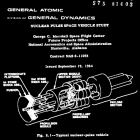 A report prepared by the Future Projects Office of NASA’s Marshall Spaceflight Center and General Atomic, the nuclear power division of General Dynamics, outlines in great detail ways that existing rocket technology (namely the Saturn V, which will not fly until 1967) and theoretical nuclear pulse propulsion technology could be combined to facilitate exploration of the moon and Mars. (Though derived from the Project Orion studies of the late 1950s, the potential nuclear-powered NASA program suggested in this document is not referred to as Orion.) The report, over 174 pages, goes into great detail about crew module design, radiation exposure, ways to mitigate the inevitable ablation of the “pusher plate” at the rear of the vehicle that will absorb a series of nuclear explosions at close range and translate the energy released into forward thrust, and even possible catastrophic launch abort modes, many of which would qualify as at least a small nuclear disaster. Even the health effects on civilian onlookers of a successful launch are considered, from retinal damage caused by viewing high-altitude firings of the nuclear propellant explosions to fallout risks, as well as potential collateral damage to satellites and non-hardened computers resulting from repeated electromagnetic pulses. The mission profiles considered are constrained to lunar missions and missions to Mars. (It’s worth noting that, by the time of this report’s issuance, the Nuclear Test Ban Treaty has been ratified by both the U.S. and the U.S.S.R., making it illegal to put nuclear pulse propulsion into practice.)
A report prepared by the Future Projects Office of NASA’s Marshall Spaceflight Center and General Atomic, the nuclear power division of General Dynamics, outlines in great detail ways that existing rocket technology (namely the Saturn V, which will not fly until 1967) and theoretical nuclear pulse propulsion technology could be combined to facilitate exploration of the moon and Mars. (Though derived from the Project Orion studies of the late 1950s, the potential nuclear-powered NASA program suggested in this document is not referred to as Orion.) The report, over 174 pages, goes into great detail about crew module design, radiation exposure, ways to mitigate the inevitable ablation of the “pusher plate” at the rear of the vehicle that will absorb a series of nuclear explosions at close range and translate the energy released into forward thrust, and even possible catastrophic launch abort modes, many of which would qualify as at least a small nuclear disaster. Even the health effects on civilian onlookers of a successful launch are considered, from retinal damage caused by viewing high-altitude firings of the nuclear propellant explosions to fallout risks, as well as potential collateral damage to satellites and non-hardened computers resulting from repeated electromagnetic pulses. The mission profiles considered are constrained to lunar missions and missions to Mars. (It’s worth noting that, by the time of this report’s issuance, the Nuclear Test Ban Treaty has been ratified by both the U.S. and the U.S.S.R., making it illegal to put nuclear pulse propulsion into practice.)
Starfish Prime
 The United States launches the Starfish Prime high-altitude nuclear weapons test, detonating a 1.4 megaton warhead at an altitude of 250 miles, the largest space-based nuclear test to date. The flash of the detonation creates a brief “false sunrise” over much of the Pacific Ocean, as well as an unusual auroral display resulting from the sudden release of charged particles trapped within Earth’s magnetic field. An electromagnetic pulse is also observed, more powerful than expected, causing some damage to the Hawaiian power grid. The radiation released in low Earth orbit also interferes with some satellites, including shortening their operational life spans (this includes the Telstar communications satellite, not launched until the next day). Starfish Prime is part of the “Fishbowl” series of high-altitude nuclear tests.
The United States launches the Starfish Prime high-altitude nuclear weapons test, detonating a 1.4 megaton warhead at an altitude of 250 miles, the largest space-based nuclear test to date. The flash of the detonation creates a brief “false sunrise” over much of the Pacific Ocean, as well as an unusual auroral display resulting from the sudden release of charged particles trapped within Earth’s magnetic field. An electromagnetic pulse is also observed, more powerful than expected, causing some damage to the Hawaiian power grid. The radiation released in low Earth orbit also interferes with some satellites, including shortening their operational life spans (this includes the Telstar communications satellite, not launched until the next day). Starfish Prime is part of the “Fishbowl” series of high-altitude nuclear tests.
AN602: Tsar Bomba
 The Soviet Union detonates the most powerful thermonuclear weapon built to date, code-named AN602, or, more informally, “Tsar Bomba”. Though it’s designed to deliver a yield of 100 megatons, the 27-ton device is only fueled enough to produce a 50-megaton explosion, still enough to be detected by other nations. (A U.S. reconnaissance aircraft is close enough to witness the detonation, so the test is hardly a secret to the western world.) The detonation registers on seismic sensors, and interferes with radio transmissions nearby for nearly an hour; the explosion is visible as far away as Norway and Alaska. Due to modifications made to avoid endangering the Soviet population, fallout is minimal, though that might not be the case were the weapon to be deployed offensively.
The Soviet Union detonates the most powerful thermonuclear weapon built to date, code-named AN602, or, more informally, “Tsar Bomba”. Though it’s designed to deliver a yield of 100 megatons, the 27-ton device is only fueled enough to produce a 50-megaton explosion, still enough to be detected by other nations. (A U.S. reconnaissance aircraft is close enough to witness the detonation, so the test is hardly a secret to the western world.) The detonation registers on seismic sensors, and interferes with radio transmissions nearby for nearly an hour; the explosion is visible as far away as Norway and Alaska. Due to modifications made to avoid endangering the Soviet population, fallout is minimal, though that might not be the case were the weapon to be deployed offensively.
Nuclear Pulse Propulsion
 As part of a post-Manhattan-Project program of seeking peaceful uses for the technology previously developed for the construction and delivery of nuclear weapons, an informal report authored in August by C.J. Everett and Stanislaw Ulam is distributed from Los Alamos National Laboratory to the Atomic Energy Commission and other interested parties on this date. The report outlines a theoretical space propulsion system which would eject and detonate a series of nuclear explosives behind a spacecraft, pushing it forward at high velocity. The suggested spacecraft design would carry a pusher plate and shock-absorber system to minimize the acceleration effects on crew members in a shielded payload section. This is the culmination of a series of ideas Ulam had devised over the past decade, which would theoretically put interplanetary or even interstellar travel within reach. As the space race heats up, Ulam and Everett’s proposal will be revisited and expanded upon, at least on paper; physicist Freeman Dyson, in particular, will spend considerable time and research on what will come to be known as Project Orion (unrelated to the 21st century Orion crewed spacecraft design).
As part of a post-Manhattan-Project program of seeking peaceful uses for the technology previously developed for the construction and delivery of nuclear weapons, an informal report authored in August by C.J. Everett and Stanislaw Ulam is distributed from Los Alamos National Laboratory to the Atomic Energy Commission and other interested parties on this date. The report outlines a theoretical space propulsion system which would eject and detonate a series of nuclear explosives behind a spacecraft, pushing it forward at high velocity. The suggested spacecraft design would carry a pusher plate and shock-absorber system to minimize the acceleration effects on crew members in a shielded payload section. This is the culmination of a series of ideas Ulam had devised over the past decade, which would theoretically put interplanetary or even interstellar travel within reach. As the space race heats up, Ulam and Everett’s proposal will be revisited and expanded upon, at least on paper; physicist Freeman Dyson, in particular, will spend considerable time and research on what will come to be known as Project Orion (unrelated to the 21st century Orion crewed spacecraft design).
Castle Bravo
 The United States’ thermonuclear testing program Operation Castle commences with the first detonation, code named Castle Bravo, on a reef near Bikini Atoll. The most powerful hydrogen bomb detonation carried out by the American military during the 20th century, Castle Bravo has a yield of 15 megatons, three times greater than predicted, with a blast radius of over four miles. Radioactive fallout spreads over 7,000 square miles of the Pacific Ocean, including neighboring islands and a Japanese fishing boat, with both populations showing symptoms of radiation sickness shortly afterward, forcing evacuations and later reparations.
The United States’ thermonuclear testing program Operation Castle commences with the first detonation, code named Castle Bravo, on a reef near Bikini Atoll. The most powerful hydrogen bomb detonation carried out by the American military during the 20th century, Castle Bravo has a yield of 15 megatons, three times greater than predicted, with a blast radius of over four miles. Radioactive fallout spreads over 7,000 square miles of the Pacific Ocean, including neighboring islands and a Japanese fishing boat, with both populations showing symptoms of radiation sickness shortly afterward, forcing evacuations and later reparations.
RDS-6s
 The Soviet Union detonates its first hydrogen bomb, code named RDS-6s, in its first thermonuclear weapons demonstration. The bomb is estimated to have a yield of 400 kilotons, thanks to a layered design devised by nuclear physicist (and later political exile) Andrei Sakharov, though Sakharov’s design is incapable of being scaled up, ending its use in later Soviet nuclear weapon designs.
The Soviet Union detonates its first hydrogen bomb, code named RDS-6s, in its first thermonuclear weapons demonstration. The bomb is estimated to have a yield of 400 kilotons, thanks to a layered design devised by nuclear physicist (and later political exile) Andrei Sakharov, though Sakharov’s design is incapable of being scaled up, ending its use in later Soviet nuclear weapon designs.
Ivy Mike
 The United States conducts the first-ever successful test of a thermonuclear bomb at Enewetak Atoll in the Pacific Ocean as part of Operation Ivy. The explosion resulting from the first hydrogen bomb test has a yield equivalent to 10 megatons of TNT, with a three-mile blast radius, stripping vegetation from the ground in the surrounding area. There is significant radiological fallout from the event, and one pilot assigned to fly a jet fighter through the area an hour after the detonation loses control of his plane, crashes, and dies due to residual radiation interfering with his instruments and controls. Traces of the previously undiscovered (but theorized) elements einsteinium and fermium are found afterward.
The United States conducts the first-ever successful test of a thermonuclear bomb at Enewetak Atoll in the Pacific Ocean as part of Operation Ivy. The explosion resulting from the first hydrogen bomb test has a yield equivalent to 10 megatons of TNT, with a three-mile blast radius, stripping vegetation from the ground in the surrounding area. There is significant radiological fallout from the event, and one pilot assigned to fly a jet fighter through the area an hour after the detonation loses control of his plane, crashes, and dies due to residual radiation interfering with his instruments and controls. Traces of the previously undiscovered (but theorized) elements einsteinium and fermium are found afterward.
Operation Hurricane
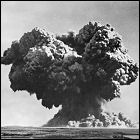 Operation Hurricane, the first test detonation of a British-built atomic bomb, takes place aboard a Royal Navy frigate anchored near the Monte Bello Islands off of the western Australian coast. The detonation has a yield of 25 kilotons, and is remotely detonated aboard the frigate to gauge the damage that would result from a scenario in which a nuclear device is smuggled into a sea port aboard a ship. This is a continuation of Britain’s own nuclear weapon development program initiated during World War II, and makes the U.K. the third nuclear-armed nation on Earth.
Operation Hurricane, the first test detonation of a British-built atomic bomb, takes place aboard a Royal Navy frigate anchored near the Monte Bello Islands off of the western Australian coast. The detonation has a yield of 25 kilotons, and is remotely detonated aboard the frigate to gauge the damage that would result from a scenario in which a nuclear device is smuggled into a sea port aboard a ship. This is a continuation of Britain’s own nuclear weapon development program initiated during World War II, and makes the U.K. the third nuclear-armed nation on Earth.
RDS-1
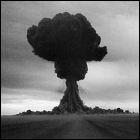 The Soviet Union detonates its first nuclear weapon, internally code named RDS-1, near a specially-built “dummy” village which includes various structures, aircraft and other military hardware, and livestock, all present to test the effects of an atomic weapon detonation in their vicinity. Western intelligence is caught off guard when the radioactive fallout is picked up by detection equipment on weather reconnaissance flights between Japan and Alaska, as the Soviets were not expected to have their own nuclear weapons until sometime in the 1950s. This is a turning point in the Cold War, initiating the race toward the next evolution of nuclear weapons: the hydrogen, or thermonuclear, bomb.
The Soviet Union detonates its first nuclear weapon, internally code named RDS-1, near a specially-built “dummy” village which includes various structures, aircraft and other military hardware, and livestock, all present to test the effects of an atomic weapon detonation in their vicinity. Western intelligence is caught off guard when the radioactive fallout is picked up by detection equipment on weather reconnaissance flights between Japan and Alaska, as the Soviets were not expected to have their own nuclear weapons until sometime in the 1950s. This is a turning point in the Cold War, initiating the race toward the next evolution of nuclear weapons: the hydrogen, or thermonuclear, bomb.
The Atomic Energy Act of 1946
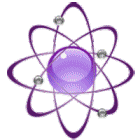 President Truman signs the Atomic Energy Act into law, laying the groundwork for both future military development of nuclear weapons and a civilian nuclear energy industry, though the latter will take time (and further amendments to the law) to develop. The primary development of the initial version of the law is the founding of the U.S. Atomic Energy Commission, a civilian agency intended to lead both areas of development (and intended to take over from the scientists who, up until now, had been operating in secret as part of the Manhattan Project). Over time, the Commission’s responsibilities will grow to include regulation, safety, and disposal of dangerous radioactive material. Major amendments will be made in 1954 under President Eisenhower to encourage the peacetime nuclear power industry to grow.
President Truman signs the Atomic Energy Act into law, laying the groundwork for both future military development of nuclear weapons and a civilian nuclear energy industry, though the latter will take time (and further amendments to the law) to develop. The primary development of the initial version of the law is the founding of the U.S. Atomic Energy Commission, a civilian agency intended to lead both areas of development (and intended to take over from the scientists who, up until now, had been operating in secret as part of the Manhattan Project). Over time, the Commission’s responsibilities will grow to include regulation, safety, and disposal of dangerous radioactive material. Major amendments will be made in 1954 under President Eisenhower to encourage the peacetime nuclear power industry to grow.
Trinity
 The United States Army, and a retinue of scientists who have participated in the top-secret Manhattan Project to create a workable atomic bomb before the then-hostile governments of Germany or Japan can do so, carry out the first detonation of a nuclear weapon in human history, generating a massive explosion with a yield of 22 kilotons of TNT. This is the final test before the deployment of two nuclear weapons in the United States’ war with Japan mere weeks later. Manhattan Project scientists present to witness the test include Robert Oppenheimer, Richard Feynman, Enrico Fermi, and John von Neumann.
The United States Army, and a retinue of scientists who have participated in the top-secret Manhattan Project to create a workable atomic bomb before the then-hostile governments of Germany or Japan can do so, carry out the first detonation of a nuclear weapon in human history, generating a massive explosion with a yield of 22 kilotons of TNT. This is the final test before the deployment of two nuclear weapons in the United States’ war with Japan mere weeks later. Manhattan Project scientists present to witness the test include Robert Oppenheimer, Richard Feynman, Enrico Fermi, and John von Neumann.